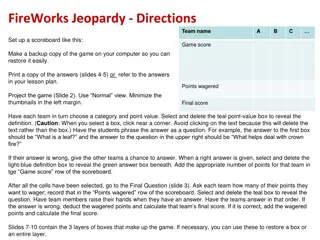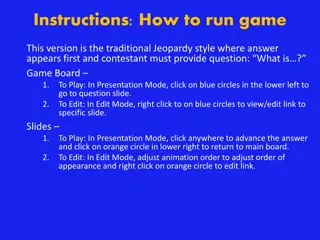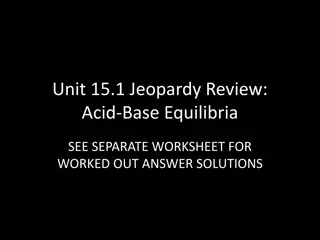
Science Review Game on Work, Power, and Machines
Explore the concepts of work, power, and machines through an engaging review game. Learn about units of measurement, such as Joule and Watt, and solve problems related to work done, power used, and efficiency of machines.
Download Presentation

Please find below an Image/Link to download the presentation.
The content on the website is provided AS IS for your information and personal use only. It may not be sold, licensed, or shared on other websites without obtaining consent from the author. If you encounter any issues during the download, it is possible that the publisher has removed the file from their server.
You are allowed to download the files provided on this website for personal or commercial use, subject to the condition that they are used lawfully. All files are the property of their respective owners.
The content on the website is provided AS IS for your information and personal use only. It may not be sold, licensed, or shared on other websites without obtaining consent from the author.
E N D
Presentation Transcript
Physical Science Chapter 14 Review Game
Work and Power Mechanical Advantage Efficiency Machines 1 point 1 point 1 point 1 point 2 points 2 points 2 points 2 points 3 points 3 points 3 points 3 points 4 points 4 points 4 points 4 points 5 points 5 points 5 points 5 points
Work is commonly measured in this unit. 1 point Check
What is the Joule? 1 point Back to Category Slide
Power is commonly measured in this unit. 2 points Check
What is the Watt? 2 points Back to Category Slide
A weightlifter uses 800 N of force to lift a barbell. If the distance he lifts the barbell is 0.75 m this is the work done on the barbell. 3 points Check
What is 600 Joules? 3 points Back to Category Slide
A book is lifted from the floor to a bookshelf 1.25 m straight up. A force of 225 N is exerted in 1.5 seconds. This is the power used. 4 points Check
What is 187.5 Watts? 4 points Back to Category Slide
A boy is exerting 100 watts of power while scooping snow. If he scoops snow for 10 minutes this is how much work he does. 5 points Check
What is 60,000 Joules? 5 points Back to Category Slide
The reason why a machine can never have 100% efficiency. 1 point Check
What is friction? 1 point Back to Category Slide
A 4 meter ramp is used to lift a 300 N box up a distance of 1.5 meters. 175 N of force is used to push the box up the ramp. This is the efficiency of the ramp. 2 points Check
What is 64%? 2 points Back to Category Slide
A machine that uses 1245 J of work to operate and applies 850 J of work on a crate has this for efficiency. 3 points Check
What is 68% efficiency? 3 points Back to Category Slide
A machine is considered efficient if it is 85% effective. If the work input is 950 J, this would be the work output. 4 points Check
What is 807.5 J of work? 4 points Back to Category Slide
A 15 meter long ramp is used to put cars onto the 2nd level of a building that is 4 meters high. A car has a weight of 500 kg and a force of 1600 N is used to push it up the ramp this is the efficiency. 5 points Check
What is 81.7% efficiency? 5 points Back to Category Slide
List the six simple machines. 1 point Check
What are the lever, pulley, screw, wedge, inclined plane, and wheel and axel? 1 point Back to Category Slide
This simple machine type has 3 different classes. 2 points Check
What is the lever? 2 points Back to Category Slide
The name of the pulley system pictured to the right. 3 points Check
What is a compound or block and tackle pulley? 3 points Back to Category Slide
The location of the fulcrum for a first class lever. 4 points Check
What is between the input arm and the output arm? 4 points Back to Category Slide
A knife, chisel, and ax blade are considered this type of simple machine. 5 points Check
What is a wedge? 5 points Back to Category Slide
The ideal mechanical advantage of the pulley system pictured to the right. 1 point Check
What is 4? (remember the number of ropes of a pulley system equals it IMA; excluding the one you are pulling on.) 1 point Back to Category Slide
Input(radius) / Output(radius) = MA A steering wheel has a radius of 14 cm and the axle has a radius of 2.5 cm. This the MA of the wheel and axel. 2 points Check
What is 5.6 MA? 2 points Back to Category Slide
MA = Distance of ramp / Height of ramp A ramp has a height of 3.5 meters and a distance of 12.4 meters. This is the MA of the ramp. 3 points Check
What is 3.5 MA? 3 points Back to Category Slide
MA = input arm / output arm A lever has an output arm length of 25 cm and an input arm of 100 cm. This is the MA of the lever. 4 points Check
What is 4 MA? 4 points Back to Category Slide
The elephant weighs 2000 N. This is the force the monkey is using to pull him up. 5 points Check
What is 400 N? 5 points Back to Category Slide






















